Introduction
This was our first trip to Vietnam although we’d both had previous experience of birding in Southeast Asia.
Flights were booked with Singapore Airlines via Wildwings:
Web: www.wildwings.co.uk
Email: wildinfo@wildwings.co.uk
Tel: 01179 658 333
All accommodation and transport were booked with the well-known Mr Viet:
Web: www.vietnamtravel.net
Email: Vietnguyen@vietnamtravel.net
Although Mr Viet was very polite and organised, and always managed to stay one step ahead of us despite our last minute changes, we did have some problems in the south with our driver not knowing where some of the birding sites were. Luckily we had directions to fall back on (to De Linh and Ta Nung) but it did cost us a morning’s birding, and a hell of a climb up the wrong track!
Mr Viet charged us US$900 per person including the internal flight from HCM to Hanoi. Our driver in the south (Ha – not sure about the spelling) stayed with us at Da Lat, was a great character and very helpful despite his limited English. It’s probably worth asking for Ha as he’s reliable and definitely knows exactly where the 4 key sites are now!
We would particularly recommend 3 previously published trip reports:
· Frank Rheindt, 2003 www.worldtwitch.com/vietnam_rheindt.htm Particularly useful for site species lists as Frank is so thorough. We regularly referred to this to check we’d seen ‘everything’.
· Sam Woods & Andy Adcock, 2002 - available from the OBC, www.orientalbirdclub.org Great for logistics and site details, with very good maps. Doesn’t include De Linh however.
· Allan Drewitt & Sue Rees, 2005 www.surfbirds.com/trip_report.php?id=640 A mirror trip to ours but slightly earlier in the year. A very useful update and we’ve tried to minimise duplication. De Linh not included.
Itinerary
Thursday 10th Long-haul Manchester-Singapore-HCM
Friday 11th Transfer HCM Airport-Da Lat with short stop at De Linh en route
Saturday 12th Ta Nung
Sunday 13th Lang Bian
Monday 14th Morning at Lang Bian; afternoon De Linh
Tuesday 15th De Linh
Wednesday 16th Morning De Linh; afternoon Cat Tien
Thursday 17th & Friday 18th - Cat Tien
Saturday 19th Morning Cat Tien; afternoon transfer to HCM Airport-Hanoi
Sunday 20th Morning Hanoi; afternoon Tam Dao
Monday 21st Morning Tam Dao
Tuesday 22nd Morning Xuan Thay
Wednesday 23rd to Sunday 27th - Cuc Phuong
Monday 28th Cuc Phuong (late transfer to Hanoi)
Tuesday 29th Long-haul Hanoi-Singapore-Manchester
Information on Deo Nui San, the now-popular De Linh site, is generally a bit thin on the ground so we concentrate on it here and provide a map.
We’ve included what we believe to be the most useful info for trip planning, additional to the 3 reports listed above, at the start of each site section. Subsequent bird lists are ‘edited highlights’ only, and the text is more anecdotal but hopefully still of interest.
The Country
Getting about in Vietnam is interesting. The sheer volume of scooter traffic in Saigon is amazing and the idea of public transport seems to have passed them by. Driving is frantic as per most Asian countries. “You need nerves of steel and eyes up you’re a*se” was one memorable phrase coined during the trip. We were told that visitors are not allowed to drive in Vietnam.
Mile after mile of paddy fields entirely devoid of birds was a new experience for us. Judging from the sadly well-known liberal nature of Vietnamese restaurant menus, they’re empty because all the birds are in the pot. It was good to see that the restaurants at both Cat Tien and Cuc Phuong did not offer wild birds. We didn’t find it difficult to resist the lure of ‘sparrowhawk’ offered on one Da Lat menu…
Vietnamese officials, particularly in the south, were noticeably surly, often avoiding eye contact, never smiling and communicating in single syllables. Presumably this is some sort of hangover from the ‘American War’. That said, they were nothing but helpful and the everyday people were as friendly and smiling as the vast majority of SE Asians we meet.
All in all it’s a great country to visit with terrific birding sites and birds. No doubt a trip to the northern or central mountains would only add to the experience. Hopefully more of the central sites will become easily accessible in the near future making more endemic species and subspecies possible for the keen birder and encouraging more experienced birders to make return visits.
Sites
Da Lat
We stayed at the Sapa Hotel. Our room was adequate but there is better looking accommodation in Da Lat. We found the Blue Sky Café/Restaurant to be an excellent place to eat and all of the waiters spoke very good English. Of note, cars are not allowed to drive through the town center between 20:00 and 10:00 on weekends but it didn’t interfere with traveling to the birding sites. Little Swifts were nesting in the hotel eaves.
Ta Nung
Our driver did not know where this site was which led us to bird the wrong track in the morning. This undrivable track is after the correct turning, by a small clearing on the left hand side of the road. It leads to an area of badly degraded forest a couple of kilometers down the valley from the real site. We managed to find the correct drivable track at mid-day and returned to the site in the afternoon. Woods & Adcock’s directions are good but look out for the 4 pines as soon as the good forest is visible in the valley on the left – the track itself is not at all obvious.
We did see several species in the degraded forest that were not seen elsewhere on the trip including White-rumped Munia, Slender-billed Oriole, Moustached Barbet, Blue-throated Flycatcher and several Black Eagles.
It didn’t take long for a pair of Grey-crowned Crocias to show once we were in the right place, and they showed well for over 10 minutes. Other birds at this segment of primary forest included Indochinese Magpie, Black-throated Sunbird, Little Heron, Spot-throated Babbler and a superb, close Streaked Spiderhunter.
Mount Lang Bian
Despite information to the contrary, early morning jeep rides up to the track which leads to the best birding area are available by booking the day before at the ranger’s office at the car park entrance. However it is a very pleasant 1 ½ hour early morning walk up, during which we saw some very nice birds. Note that we only located a Collared Laughingthrush in the saddle area because DT heard it moving amongst dry leaves on the ground. We had tried playback so perhaps it had come in silently.
The walk up produced Large Hawk Cuckoo, Grey-chinned & Long-tailed Minivets, Grey Bushchat, Chestnut-vented Nuthatch, Green-backed Tit and Paddyfield & Olive-backed Pipits amongst others. In the pines between the road and where the trail starts to go down to the saddle area we found Black-throated Tit, White-browed Shrike Babbler, Grey-capped Pygmy Woodpecker, Large Cuckooshrike, White-throated Rock Thrush, Gould's Sunbird and a couple of stunning Vietnamese Greenfinch.
The best birds were seen in the saddle area. Just before the trail splits we had Blue-winged Minla and good views of Lesser Shortwing. From where the trail splits, the left-hand contour trail produced a good mixed flock with Yellow-cheeked Tit, Silver-eared Mesia, Rufous-winged Fulvetta and Chestnut-fronted Shrike Babbler. A Collared Laughingthrush showed here but only for a moment.
Heading along the right-hand trail by the first large fallen tree, AM had a brief pair of Cutia, and another pair (2 males) showed superbly the following day where the trail starts to get quite steep towards the summit. Rustling leaves gave away the location of a feeding Collared Laughingthrush in the same area as the first pair of Cutia. Other birds seen along this trail included Large Niltava, Golden-throated Barbet, Black Baza, Green Cochoa (heard only), Eye-browed & Siberian Thrushes and Black-headed Sibia.
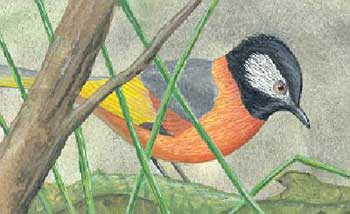
Deo Nui San, De Linh
Our accommodation was annoyingly at Bao Loc, which is an hour’s drive from the birding site, Deo Nui San and meant a couple of very early starts. Mr Viet assures us that birders are prohibited from staying in De Linh itself because of police safety advice. We are skeptical of the risks though and would suggest that if birders politely pressurise Mr V, things could change. It’s a 30-minute drive from De Linh to Deo Nui San, making it a reasonable journey breaker if time allows.

We managed to include a couple of short visits here which were very worthwhile and produced a few species not seen again including endemic Black-hooded Laughingthrushes and Chestnut-crowned warbler. We also had one full day and a morning, which were both excellent. Green Cochoa’s seemed relatively common with birds heard calling regularly, and at least 5 individuals seen after crossing the stream, including a very obliging first summer bird c.100m up the jeep track.
After having a very brief view of a probable Rusty-naped Pitta in dense cover just beyond the stream crossing, several hours staking out the area proved very unproductive. However in true Teece and Mears style, AM’s mosquito net was set up as a screen the following morning in the clearing giving us a good view along the trail and into the area where the bird had been seen. An hour and a half later we heard a rustling in the small patch of vegetation just feet behind us! Whatever it was then began to move around us, still remaining extremely close. Not knowing what to do for the best DT slowly turned to look over his shoulder to find a Rusty-naped Pitta no more than 2m away. It quickly moved behind a large tree and out of sight until AM saw it dash across the trail never to be seen again. Blue Pittas were heard a few times but not seen. Note that other birders have had good views of both pitta species in this area.
A skulking Orange-breasted Laughingthrush was seen just behind the shop, while another was heard close to the stream crossing. Good mixed flocks were seen which included Red-billed Scimitar Babbler, Rufous-backed Sibia, Grey-headed Parrotbill and Velvet-fronted Nuthatch. Other good birds seen were several Long-tailed Broadbills; Black-browed Barbet; Red-headed Trogon; Ferruginous Flycatcher; Spotted Forktail; White-cheeked Laughingthrush; White-throated Rock Thrush; Silver Pheasant; and Maroon Oriole.
In summary this was a very productive and enjoyable site. While we were there no one else was seen on the trail; however the noise of chainsaws and ancient trees crashing to the ground was never far away so unfortunately its future seems far from certain. Our first Green Cochoa showed extensive orange on the underparts, initially a great surprise and it was a few moments before we realised what species we were watching. DT’s bird of the trip.
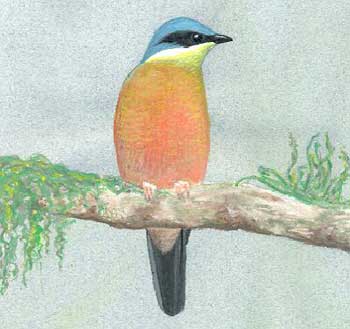
Cat Tien
Unfortunately AM was unwell during our stay here. Still we had some excellent birds, which included good views of Bar-bellied Pittas close to the HQ for DT mid-afternoon on 17th. A very obliging male Blue-rumped Pitta was then seen to catch a small snake! Returning with a slightly dazed AM an hour later, the bird was found in the same area and was joined by a female. This pair was also seen along the same trail by another couple of English birders (Eddie and Simon) and by a Thai birder over subsequent days. We’ll describe the spot since the birds were obviously settled in the area and it may be a reliable location for the future. From the HQ, walk the road towards Dac Lua; take the first signed trail on the left (after about 10 minutes); this splits after no more than 50m; bear right and you’ll soon come across a large rock in the middle of the trail. This is the spot. In fact, DT was sat on this rock when he first noticed the male Blue-rumped standing less than 2m away! Freezing rather than moving away from an intruder appears to be a trait of Blue-rumped Pitta. How many did we walk past…?!
We would recommend that you don’t under-estimate the differences between sub-species of Blue-rumped Pittas. The soror male is a simply beautiful bird. AM freely admits that his sketch doesn’t do its dusty, pastel head colours justice (and perhaps no published illustrations do either). AM’s bird of the trip.
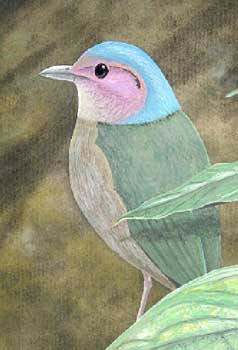
Other birds seen along this trail and around the HQ included Great Hornbill; Great Slaty Woodpecker; Red-breasted Parakeet; Pied & Stork-billed Kingfishers; Blue-bearded & Chestnut-headed Bee-eaters; Violet Cuckoo; Silver-backed Needletail; Black-hooded Oriole; Lesser Adjutant; Woolly-necked Stork; Golden-fronted Leafbird; Golden-crested Myna; Velvet-fronted Nuthatch; and Ruby-cheeked Sunbird.
Dac Lua
Frank Rheindt describes a good route into the bamboo but note that to find Frank’s trail, you initially have to walk the very obvious path/track with smallholdings on the right and a canal on the left. Despite finding Frank’s site, we neither heard nor saw Orange-necked Partridge. It was very hot and dry though and perhaps we’d have had more luck if we’d been in amongst the bamboo for dawn.
Very little was seen here in fact with the best birds being Grey-headed Woodpecker, Pale-legged Warbler, Racket-tailed Treepie and Scaly-breasted Partridge (beware!); both Pale-headed Woodpecker and Germain’s Peacock Pheasant were heard calling only.
Crocodile Lake
Our morning didn’t give us enough time here, a couple of days probably being needed to get the most out of the site, and perhaps even a guided boat trip.
Despite the limited amount of time, we saw some nice birds along the trail including Siamese Firebacks, one Germain’s Peacock Pheasant crossing the trail, Heart-spotted Woodpecker, and Banded Broadbill. The highlight of the morning however, was multiple views of Bar-bellied Pittas with perhaps 8 different individuals seen, several of which gave lovely views. They were usually heard moving through the dry leaf litter or calling and are obviously common along this trail. Once heard, it was the male’s glowing head that often drew attention to the bird’s exact location.
Birds seen at the lake included Lesser Whistling Duck; Cotton Pygmy Goose; Stork-billed & Pied Kingfishers; Purple Swamphen; Bronze-winged Jacana; Osprey; Crested Serpent Eagle; and Yellow Bittern.
Tam Dao
We only spent an afternoon and a short morning here, partly because we discovered recent news of the well-known Watertank Trail’s demise the previous evening in our Hanoi hotel; and partly because it was cold with heavy fog on both days. This is not unusual at Tam Dao and although we’d scanned web weather reports the previous evening, we’d still been unable to discern whether or not it was worth a visit. In the end we took our chances but were out of luck. We birded the forested roads close to the Green World Hotel and the waterfall trail that starts to the left of the Mela Hotel. We ate in the Mela and an open fire was welcome during the evening despite a mixture of fog and smoke rolling through the restaurant throughout.
Only a few birds were seen and the undoubted highlights were excellent, prolonged views of a pair of Silver-eared Mesias and a smart White-capped Water-redstart. The former, of the multi-coloured red-throated race, were close to the Green World, while the redstart was seen easily at the foot of the waterfall steps once the weekend crowds had dispersed - a well-known stake-out.
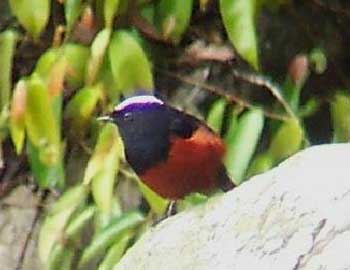
Xuan Thay(pronounced SHAN TWEE if we remember rightly…)
In view of conditions at Tam Dao, we rang Mr Viet and he arranged for our driver to collect us early and take us to Xuan Thay, the well-known Ramsar wader site. The driver had to stay at the site with us and we therefore made an additional, reasonably modest payment to Mr Viet. We stayed one night at the Ramsar Center – one night there being enough for anyone – and after a morning’s birding, moved on to Cuc Phuong. The accommodation is very poor indeed and subsequently we were told that decent hotels are just a 30-minute drive away. Our car only just made it over the deeply rutted and muddy access road to the center and a 4x4 would have been much more appropriate than a standard saloon. Still, pushing at various points was good exercise for AM and DT. The final insult came when the Center staff told us that Spoon-billed Sandpiper was very difficult to see at this time of year and an attempt would entail a 5-hour boat ride. We didn’t go for this as we’d both seen SB Sand in 2004 but again, were told subsequently that they are reasonably easy to see in March but that the Ramsar Center is not the best place from which to make the trip…
We did see our main target bird however – Black-faced Spoonbill, and had very nice views of a flock of 27 birds. No Saunder’s Gulls could be found and although the birding was quite good, only a few other interesting species were seen, including one Great Knot, Intermediate Egret, Spot-billed Duck, Black-capped & Pied Kingfishers, Whiskered & Caspian Terns, Eastern Marsh Harrier and Black-faced Bunting.
Obviously anyone planning to visit Tam Dao or Xuan Thay is advised to make detailed enquiries into the current state of the sites and practicalities for birding them. These 2 days rate amongst the most frustrating we’ve ever spent while birding in SE Asia and not having a proper try for Blue-naped Pitta was a real blow. Credit goes to Mr Viet for his flexibility but he could improve considerably on the arrangements he makes for birders at Xuan Thay, a point that we did mention to him after the trip. We felt truly sorry for the conservation staff at Xuan Thay, who appear to carry out noble work in pretty dreadful conditions.
Cuc Phuong
We stayed in a bungalow at the Bong Substation and thought it was perfect for birders. Clean and tidy with decent blankets and a good hot shower. The electricity is turned on at 6pm every day and a flask of hot water provided on request. This was great for early morning coffees, 3-in-1 sachets being available from the food store just a 5-minute walk away. The café there was fine and we also managed to get some laundry done at the substation.
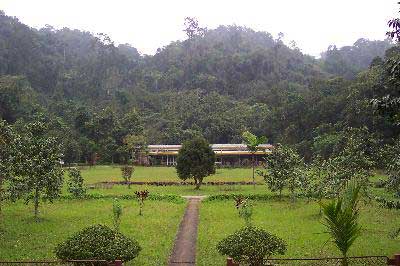
And to our great relief, excellent birding was to be had on the doorstep. It has to be said that we invested an inordinate amount of time searching for Eared Pitta but this was always in good habitat in which we inevitably saw other good birds. The pittas would call at dawn and dusk every day but never for long enough to pinpoint their location exactly. Staking out these areas only produced 1 very brief sighting of a bird that must have been simply moving through. From the calling, it was obvious that at least 2 birds, and possibly more than 4, were present close to the first steep and long incline of steps at the valley end of the Loop Trail. Only on day 5 did we eventually have good views and this was after a welcome tip-off from Craig Robson and his Birdquest crew. They’d had good views of a feeding pair near the top of the steps and fortunately the birds stayed put long enough for us to obtain excellent views too, particularly of the female. At the top of the steps, you pass a large rock right beside the trail; on your right, there is then a long, open rise bordered by limestone crags, perhaps 80m long and 10m wide; the birds were right at the top of this rise feeding in dry leaf litter close to 2 large fallen trees. No sign of them the next day though! Craig told us that this is the first time he’s ever seen Eared Pitta on his numerous Vietnam Birdquest tours and for us, this marked a satisfying end to a dual that began with 4 Eared Pitta-less days at Khao Yai in April 2004.
Other highlights at Cuc Phuong were good views of several Bar-bellied Pittas and one brief view of a Blue-rumped Pitta at dusk in fading light. The very back of the grids proved to be a particularly good area for pittas and in one 20-minute spell, we saw or heard all 3 species from here (Eared being distant calling only). Limestone Wren Babbler is also present.
Silver breasted Broadbills were common in the grids and seen along the road and Valley Trail; Long-tailed Broadbill was only heard in the grids and we only heard Grey Peacock-pheasant on one occasion on the Valley Trail; Pied Falconet showed well at the start of the Valley Trail.
We logged a great variety of forest birds and most of the Cuc Phuong specialities including Rufous-throated Fulvetta; Scaly, Blue Whistling & Japanese Thrushes; White-browed Piculet; Blue and White, White-tailed & Hainan Blue Flycatchers; Eye-browed Wren Babbler; Large Scimitar Babbler; Rufous-tailed Robin; Asian Stubtail; Orange-bellied Leafbird; and Fork-tailed Sunbird. We did miss White-winged Magpie and the incredibly difficult Red-collared Woodpecker. Other trip reports give good advice for seeing the magpie but we didn’t get round to trying for it properly. We were also told that Blythe’s Kingfisher and Rusty-naped Pitta are in the park but we cannot confirm this…
Equipment
Here are just a few notes on some of the equipment we used:
On several recent rips we’ve used a diving torch for night birding, though it didn’t get much of a work-out in Vietnam. It is however, a superb piece of kit and produces a very effective beam. It takes 4 large batteries (LR20’s) and is fully waterproof (well it would be!) but can be used out of water with no risk of overheating. Ikelite RCD is the model.
We used an mp3 player for discreet playback on this trip - a first for us, an Archos product with a Sony speaker (speaker available from Wildsounds: http://www.wildsounds.co.uk/). It was extremely good.
Finally, we attached mini-laser pointers to our bins. This was very successful indeed once we got into the habit of actually using them. During the trip, quality birds such as Bar-bellied Pitta and Green Cochoa were pointed out with them in gloomy undergrowth (and we found it very easy to avoid lasering the bird!). They attached very neatly and quickly to our bins with electrical tape. The product is ‘Micro Laser Pointer’ available from Blue Sky Marketing on the web and retailing at just GBP10 ( http://www.blueskymarketing.co.uk/ ).
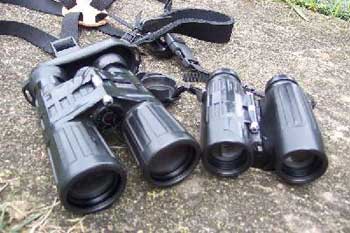
When the Rusty-naped Pitta came in just feet behind where we were sitting, a mirror would have been useful ! But maybe that’s taking the gadgetry a bit too far…
251 species were seen or heard in total.
Help in planning was received from various people and we are grateful to the following amongst others: Rob Hutchinson, Nick Senior, Frank Rheindt, Craig Robson, Jan Wilczur, Richard Thomas, Andy Pierce and of course, Mr Nguyen Van Viet.
Photos by DT; sketches by AM
denis (AT) teece78.freeserve.co.uk andy.mears (AT) wessexwater.co.uk